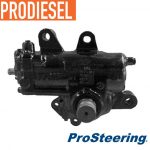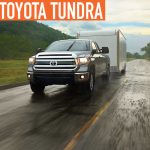Some rules are meant to be followed, some bent, and some broken. There are times, however, when adding or changing rules and regulations lead a company to push the boundaries of innovation to make not only a compliant product, but also a better, more user-friendly product. Cummins has adapted to increasingly strict exhaust regulations with grace and top-of-the-line products. From meeting exhaust regulations to new oil specifications and more, Cummins produces engines that make driving less fatigue inducing, safer, and more fun.
MWS: WHAT ENGINE DESIGN/MANUFACTURING TrendS HAVE YOU SEEN RESULTING FROM NEW AND INCOMING EXHAUST REGULATIONS AND HOW IS CUMMINS ADAPTING TO THE REGULATIONS AND COMPETITION?
RUSSO:
The exciting opportunity ahead of us as engine manufacturers is that we are at the point where the sole focus is on the customer. Today, our engine improvements are being driven by their needs, as opposed to just meeting emissions regulations. The current and future greenhouse gas (GHG) regulations are a good example—we reach them by improving fuel economy, so not only is it better for the environment, it’s lowering operating costs and making business more profitable for our customers. It’s a win-win.
To do this, the market trend is toward a greater focus on several key elements on the full vehicle: aerodynamics, downspeeding, powertrain integration, and new electronic features.
Aerodynamics: It is important to note that fuel efficiency is most affected by the rolling resistance of tires at speeds under 50 mph, while aerodynamics (cab, trailer gap, etc.) have their greatest impact at speeds greater than 50 mph. Making changes on trucks to address both of those factors simultaneously helps keep more money in the operators’ pockets. That’s why we’re seeing a growing interest in aero packages, low-profile tires, and similar components.
Downspeeding: Especially in heavy-duty trucks, by reaching peak torque quicker (at or below 1,000 rpm), we can gear the trucks to keep them in their lower rpm sweet spot for maximum fuel economy. Downspeeding can even help smaller engines like the B6.7 achieve better fuel economy for lighter pickup-and-delivery (P&D) applications. The key is providing the right amount of torque when it’s needed most, so drivers can get the job done without wasting fuel.
Powertrain integration: We are fortunate to have great collaboration with the leading transmission and axle manufacturers. Together, our open integration ensures that our engines work flawlessly within the full powertrain system and we can offer the optimized spec across a wide range of duty-cycles. Automatic, manual, or automated manual—we’ve got a fully integrated solution. This includes dynamic shifting that automatically senses when low-engine-speed shifts can be made, multispeed torque convertor lockups with automatic transmissions, and our ‘Neutral at Stop’ (Stop-Start) feature that saves fuel when the engine is stationary.
Electronic features: These are things that can be controlled by the customer once they’ve taken delivery of the vehicle. These include Vehicle Acceleration Management, Idle Shutdown, and Gear-Down Protection. Vehicle Acceleration Management maintains a constant acceleration rate off the line in unloaded trucks by ‘mimicking’ a loaded truck. This reduces unnecessary fuel consumption, as well as tire and driveline wear. Idle Shutdown, as the name implies, simply shuts the engine down after a specified length of time idling. Gear-Down Protection limits vehicle speed in lower gears, encouraging drivers to get to and stay in top gear, where the engine runs most efficiently.
Cummins has done this with our 2017 Medium-Duty engines by making minor tweaks to our proven engine platforms—the B6.7 and L9—along with the addition of the new Single Module™ aftertreatment system, which is inherently more efficient. The B6.7, especially given the applications it sees, has made big strides in fuel economy improvements with up to seven percent better fuel economy in 2017—primarily through combustion optimization. The most significant gains will be seen in intracity pickup and delivery trucks.
MWS: IS CUMMINS TAKING ANY SPECIFIC STEPS TOWARD ITS ENGINE COMPATIBILITY WITH THE NEW PC-11 OIL SPECIFICATION, SUCH AS MAKING NEW AND CURRENT ENGINES FA-4 COMPATIBLE?
RUSSO:
In 2017, our full lineup of engines will be compatible with the new PC-11 oil—CK-4—that is also backwards compatible with our older engines, even as the CJ-4 category is phased out. Our 2017 MidRange engines will utilize CK-4 oils with a first fill of 15W-40 and then ideally using 10W-30 oil in subsequent oil drains. We are currently validating the FA-4 fuel-efficiency oil for use in our 2017 heavy-duty engines.
MWS: WHAT TRENDS HAS CUMMINS SEEN IN THE DIESEL ENGINE SECTOR STEMMING FROM NEW EFFICIENCY TECHNOLOGIES AND HYBRID/ELECTRIC VEHICLE OFFERINGS?
RUSSO:
We currently offer ISB6.7 and ISL9 hybrid engine ratings in truck applications and transit buses that use an electric motor to add power to the drivetrain, thus reducing the amount of fuel needed to meet the same demand with the diesel engine only. The 2017 B6.7 will feature a new Stop-Start capability, meaning that customers can opt for a system that will automatically shut down the engine when the vehicle is stopped and power is not needed. This will dramatically reduce fuel consumption by three to 15 percent beyond the base engine. This is ideal for vehicles that make multiple stops on their route that right now may have been using up to a gallon of fuel per hour idling. This is a smart system; even while the engine is stopped, it knows to seamlessly switch to battery power to ensure continuous operation of critical functions, including the HVAC fan, interior lights, radio, GPS, and other systems. Plus, as soon as the driver takes his foot off the brake pedal, the engine will start in the fraction of a second it takes the driver’s foot to reach the accelerator.
MWS: WHAT STEPS IS THE COMPANY TAKING TO REACH A HIGH LEVEL OF SUSTAINABILITY PERTAINING TO THE WORKFORCE AND SUPPLIER DIVERSITY?
RUSSO:
Cummins has always prided itself in workforce and supplier diversity. Since J. Irwin Miller’s (Cummins Chairman from 1951-1977) leadership, we have always taken the stance that bringing in the right people and giving them freedom to create will always produce the best products. We live this mantra every day. In 2015 and 2016, we received the following recognition of those efforts: Top 50 Diversity Company by Diversity Inc.—10th consecutive year; Dow Jones Sustainability Index—11th consecutive year; perfect score in Corporate Equality Index by the Human Rights Campaign—11th consecutive year; named one of the World’s Most Ethical Companies by Ethisphere—9th consecutive year; and ranked among the World’s Best in Newsweek’s Green Rankings.
MWS: THERE IS A LOT OF EMPHASIS ON THE DRIVER SHORTAGE THE INDUSTRY IS EXPERIENCING. WITH THAT IN MIND, DOES CUMMINS HAVE A PLAN OR GOAL TO TAILOR PRODUCTS TO INCREASE DRIVER RETAINABILITY, INCLUDING SAFETY FEATURES AND FATIGUE REDUCING FEATURES?
RUSSO:
Absolutely. Drivers have always been and will always be top-of-mind as we develop our engines, as they are the greatest asset of any vehicle. Over the past few years, we have seen many more drivers not just switching from manual to automated manual or automatic transmissions, but really become promoters of the technology. The work we have done to integrate our engines with those transmissions has really helped alleviate a lot of the stress and exhaustion that drivers typically experience with manual transmissions. Merging into traffic from a jobsite, navigating intracity streets, or spending long hours on the highway, Cummins continues to work to make things easier for the driver. This doesn’t just benefit current drivers, but also opens up the career opportunity of driving a truck to a much wider range of people.
On top of the integration piece is the introduction of very helpful electronic features, especially in our heavy-duty engines. We offer ADEPT™ technology, which is a suite of advanced electronic features to help the driver. SmartTorque2 adjusts the amount of torque needed based on vehicle load, speed, and grade. SmartCoast™ will neutralize the gearbox when the vehicle is going down grades of one to four percent, allowing the vehicle to coast at neutral—all of this while the driver is in cruise control. And, Predictive Cruise Control will take that one step further in 2016. By using ‘look-ahead’ technology, the truck can read GPS information two miles ahead to effectively anticipate uphill climbs and downhill coasts. The truck accelerates just before going up the hill, and neutralizes just before it reaches the crest, then coasts down the backside for ultimate efficiency. This makes every driver look like a veteran—without any extra effort. Drivers will finish a day feeling much more relaxed and rested, ensuring a comfortable and safer working environment.
Plus, our engines are just fun to drive. We see plenty of performance-oriented fleets spec’ing our engines because drivers actually prefer to drive them—not only does this enable higher productivity, it also provides greater satisfaction behind the wheel and combats driver turnover.
MWS: ARE THERE ANY NEW PRODUCTS AND/OR FEATURES THAT CUMMINS IS LOOKING AT INTRODUCING TO THE MARKET IN THE NEAR FUTURE?
RUSSO:
The big releases you’ll see from us are our new natural gas engines from Cummins Westport—the ISB6.7 G and ISL G Near Zero—respectively, our smallest North American natural gas engine and the first engine to reach low NOx levels at the new optional standards of 0.02 g/hp-hr of NOx—a 90 percent reduction over current standards. Also, our next-generation 2017 engines—the B6.7, L9, and X15. Finally, as I mentioned earlier, the B6.7 with Stop-Start capability is going to be a very exciting new technology that will have tremendous appeal across several markets.
FOR MORE INFORMATION:
Find out more about Cummins’ products and services, visit
www.cumminsengines.com.
_______________________________________________________________________
MODERN WORKTRUCK SOLUTIONS: June 2016 ISSUE
Did you enjoy this article?
Subscribe to the FREE Digital Edition of Modern WorkTruck Solutions magazine.
![]()




